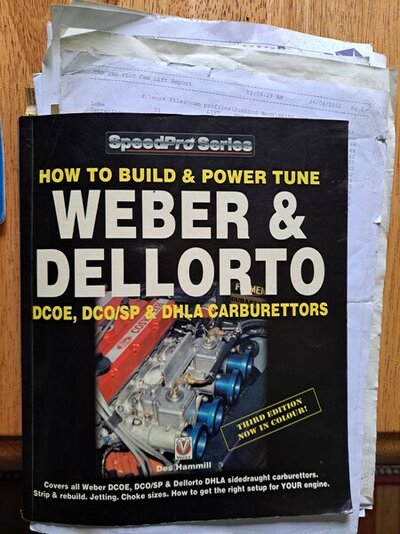1972 Dodge Colt
Modifying the progression holes should only be done as a last resort - easy to stuff it up and ruin a set of carbs. I would recommend getting the factory weber manual (think its available online as a PDF) as well as this book by Des Hammill:

Don't sweat the no vacuum port on the manifold on an individual runner system the guage would just be bouncing around like crazy so it would be difficult to get a good read on it anyway. An O2 sensor can be usefull for getting it dialed in but can sometimes lead you down the wrong path, the gauge mounted near the tach can help guide you to which circuit needs adjusting as well as where your aux venturies are starting to flow .
Get the fuel pressure sorted out first as the change in pressure will change your tune, they are pretty sensitive to it. I run mine at 3psi using a speco regulator - cheap and does the job well. Check where your idle screws are currently at, generaly less than 1 turn out from stoped the ide jet is too big, more than 2 - 2 1/2 turns its too small. Air bleed size on the idle jet size has a pretty big effect on the fuel curve through the progression phase - a 55F6 will deliver a richer mixture than a 65F8 as rpm increases. I found my engine responded well to a good bump in initial timing and a slower curve compared to where it used to like with the 4bbl setup. I also found this style carb balancer to be more accurate than the uni-syn - the one I had seemed to choke the cylinder off rather quickly even with the bypass opened all the way, plus it seals in the trumpets nicely.
But yeah lots of reading, lots of trial and error and lots of $$ on jets, aux. venturies, chokes ect. But when it's right you wouldn't have anything else.
Modifying the progression holes should only be done as a last resort - easy to stuff it up and ruin a set of carbs. I would recommend getting the factory weber manual (think its available online as a PDF) as well as this book by Des Hammill:

Don't sweat the no vacuum port on the manifold on an individual runner system the guage would just be bouncing around like crazy so it would be difficult to get a good read on it anyway. An O2 sensor can be usefull for getting it dialed in but can sometimes lead you down the wrong path, the gauge mounted near the tach can help guide you to which circuit needs adjusting as well as where your aux venturies are starting to flow .
Get the fuel pressure sorted out first as the change in pressure will change your tune, they are pretty sensitive to it. I run mine at 3psi using a speco regulator - cheap and does the job well. Check where your idle screws are currently at, generaly less than 1 turn out from stoped the ide jet is too big, more than 2 - 2 1/2 turns its too small. Air bleed size on the idle jet size has a pretty big effect on the fuel curve through the progression phase - a 55F6 will deliver a richer mixture than a 65F8 as rpm increases. I found my engine responded well to a good bump in initial timing and a slower curve compared to where it used to like with the 4bbl setup. I also found this style carb balancer to be more accurate than the uni-syn - the one I had seemed to choke the cylinder off rather quickly even with the bypass opened all the way, plus it seals in the trumpets nicely.
But yeah lots of reading, lots of trial and error and lots of $$ on jets, aux. venturies, chokes ect. But when it's right you wouldn't have anything else.